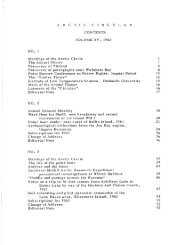Volume 4, 1951 - The Arctic Circle - Home
Volume 4, 1951 - The Arctic Circle - Home
Volume 4, 1951 - The Arctic Circle - Home
Create successful ePaper yourself
Turn your PDF publications into a flip-book with our unique Google optimized e-Paper software.
<strong>The</strong> forested region around Nejanilini Lake, about<br />
130 miles northeast of Churchill, is much more extensive<br />
than around Baralzon Lake 45 miles to the northeast, and<br />
ls a source of fuel and tent poles for a small band of<br />
Chipewyan Indians who make their summer camp near the local<br />
Hudson's Bay Company post.<br />
Caribou were reported ln the vicinity toward the<br />
middle of August, and Mr. Horace Flett, manager of the post,<br />
stated that their normal movement was back north later in<br />
the season, prior to making their final trek southward,<br />
giving the natives three 6pportunities of securing meat, of<br />
which the winter supply is taken in the fall. ln an open,<br />
swampy area near the post were the antlers and bones of<br />
scores of caribou that had met this fate.<br />
ln contrast to the subarctic coast of Manitoba at<br />
and north of Churchill, where the recorded vascular flora<br />
numbers some 370 species, the flora of the Baralzon-Nejanilini<br />
district is relatively poor, only 83 species being collected.<br />
<strong>The</strong> greater richness of the coastal flora may be explained<br />
by the occurrence of large forested areas near Churchill,<br />
the presence of extensive rock outcrops (none were observed<br />
in the Baralzon-Nejanilini district), the restriction of<br />
numerous species to the coastal salt marsh habitat, and the<br />
prevalence of a more humid, foggy climate, doubtless influenced<br />
by the voluminous discharge of the Churchill River.<br />
<strong>The</strong> cold waters of the Bay are responsible for a<br />
northward trend of isotherms parallel to its shores between<br />
York Factory and Baralzon Lake. <strong>The</strong> daily mean temperature<br />
for July of these two localities, as weIl as of Churchill,<br />
averages between 54 and 55 degrees Fahrenheit, the same as<br />
for Great Bear Lake, more than 400 miles farther north.<br />
Similarly, the July isotherm of Brochet, near the Saskatchewan<br />
border and midway in latitude between York Factory and<br />
Churchill, is the same as that of Moose Factory, at the<br />
southern tip of James Bay, where the influence of the cold<br />
water ls still evident, and a subarctlc flora exists at a<br />
latitude only 60 miles north of that of Regina. Durlng<br />
englneering operations at Port Nelson, before the decision<br />
was made to make Churchill the terminus of the Hudson Bay<br />
railway, lt was found that permanently frozen ground there<br />
extended to an average depth of about 30 feet. Richardson<br />
states that, in October, 1835, the summer heat at York Faotory<br />
had thawed the ground to a depth of three feet, beneath which<br />
was a frozen layer seventeen and a ha If feet thlck. At <strong>The</strong><br />
Rock, about 100 miles up the Hayes, frozen clay banks were<br />
seen by the writer along a small shaded stream in mid-July,<br />
1949, but it ls known that frost penetrates further lnto the












